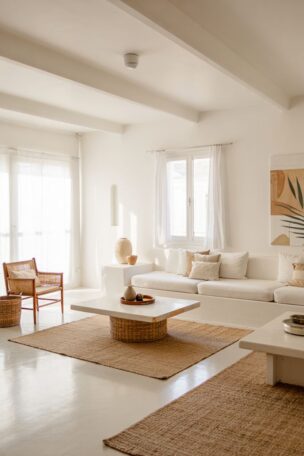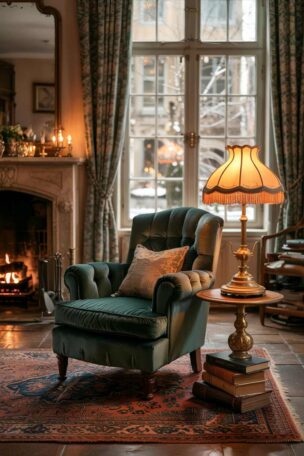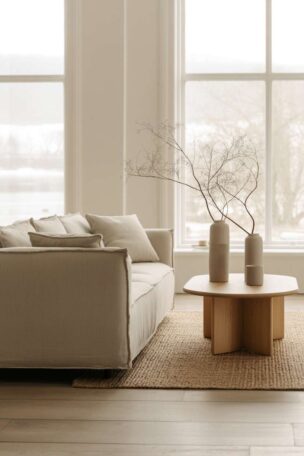In a world that often celebrates perfection and newness, wabi-sabi interior design offers a refreshing alternative.
But what is wabi-sabi? This ancient Japanese philosophy embraces imperfection, simplicity, and the natural aging process of materials.
Rooted in Zen Buddhism, wabi-sabi is more than just an aesthetic approach—it’s a mindful way of living that finds beauty in flaws and celebrates the authentic character that comes with time and use.

Unlike the glossy perfection often portrayed in design magazines, wabi-sabi interiors feel lived-in, soulful, and deeply connected to nature.
This approach has gained significant popularity as more people seek authenticity and tranquility in their homes, moving away from mass-produced furnishings toward spaces that tell stories and evolve beautifully over time.
Let’s explore what wabi-sabi style truly means and how to incorporate its principles into your home.
The Philosophy Behind Wabi-Sabi
Understanding Wabi-Sabi’s Core Principles
At its heart, wabi-sabi embraces three fundamental principles: nothing lasts, nothing is complete, and nothing is perfect.
Rather than viewing these concepts negatively, wabi-sabi finds profound beauty in impermanence, incompleteness, and imperfection.
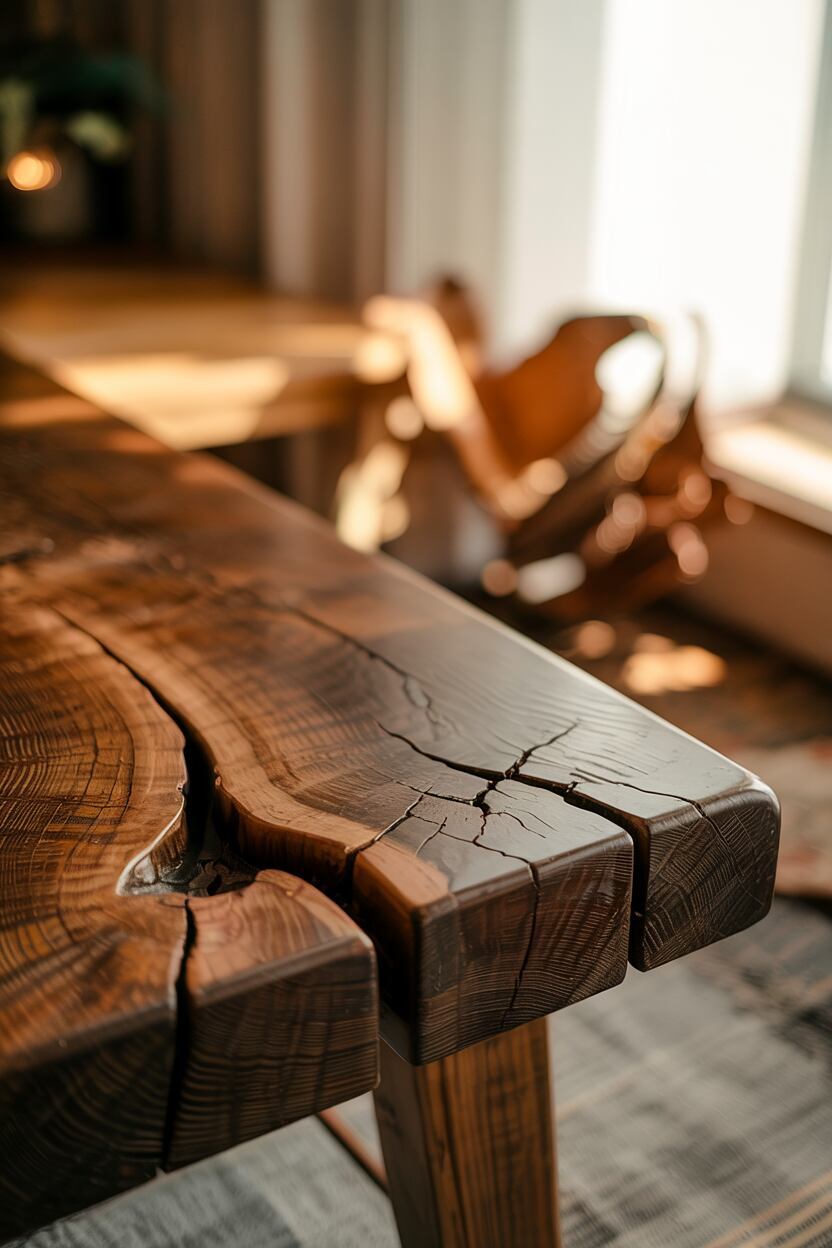
“Wabi” refers to the beauty found in simplicity and a melancholy acknowledgment of life’s transience. “Sabi” celebrates the beauty of age and the patina of wear.
Together, they create a design philosophy that rejects the pursuit of flawlessness in favor of authenticity and character.
In wabi-sabi interior design, cracks, weathering, and asymmetry aren’t seen as flaws to be fixed—they’re celebrated as marks of history, use, and the natural passage of time.
This perspective creates genuinely personal spaces that are lived in and deeply connected to the natural world.
Historical Context
Wabi-sabi has deep roots in Japanese culture, particularly in traditional tea ceremonies where simple, often imperfect vessels are prized for their authenticity and character.
The philosophy emerged as a reaction to the ornate, perfect aesthetics that dominated earlier periods.
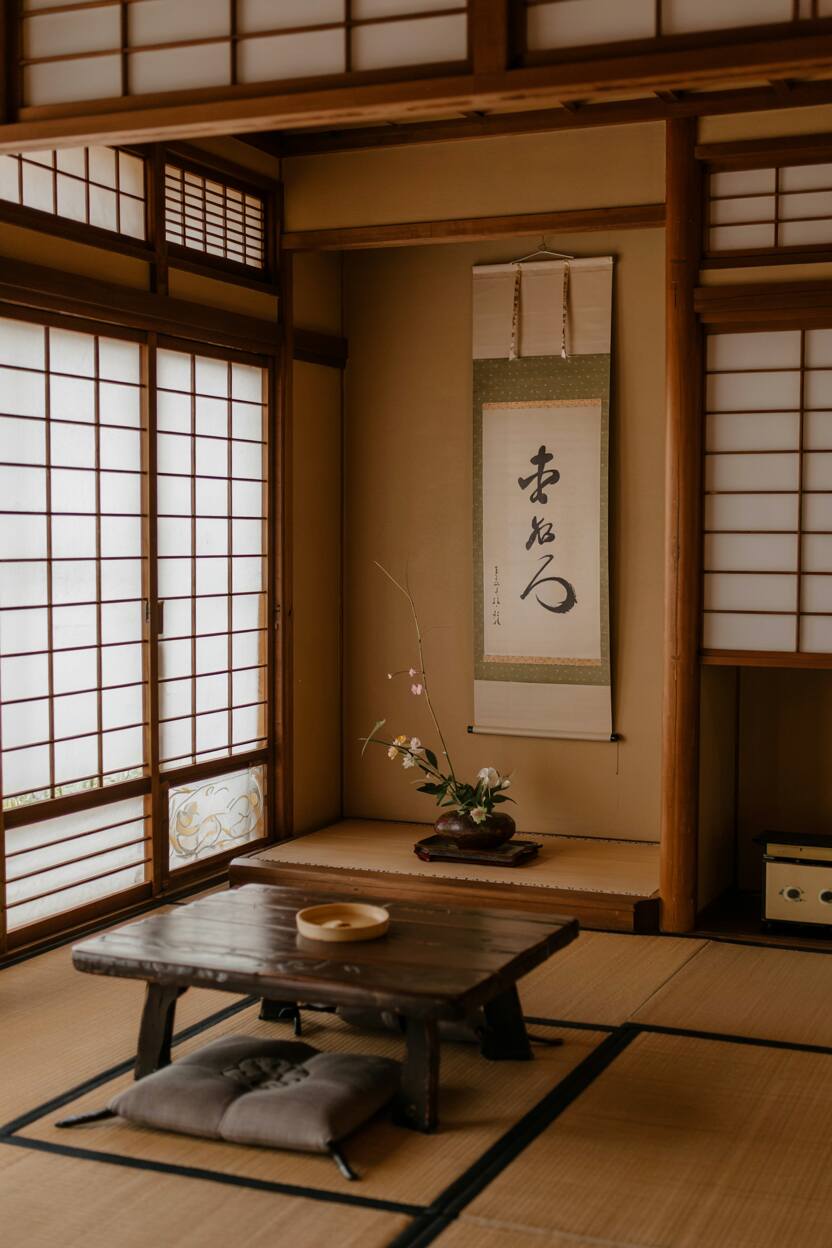
This aesthetic approach starkly contrasts many Western design philosophies that have historically valued symmetry, perfection, and grandeur.
Where Western traditions might conceal joining methods or natural variations, wabi-sabi celebrates these elements as part of an object’s unique story and character.
Over centuries, this philosophy has evolved from its spiritual origins into a broader aesthetic approach that influences everything from architecture to everyday objects.
Today, it offers a thoughtful counterpoint to our fast-paced, disposable culture, encouraging us to slow down and find beauty in the subtle, imperfect, and authentic.
Key Elements of Wabi-Sabi Interior Design
Natural Materials
At the foundation of wabi-sabi design is a deep reverence for natural materials in their most authentic forms.
These materials connect us to the earth and bring organic warmth to our spaces.
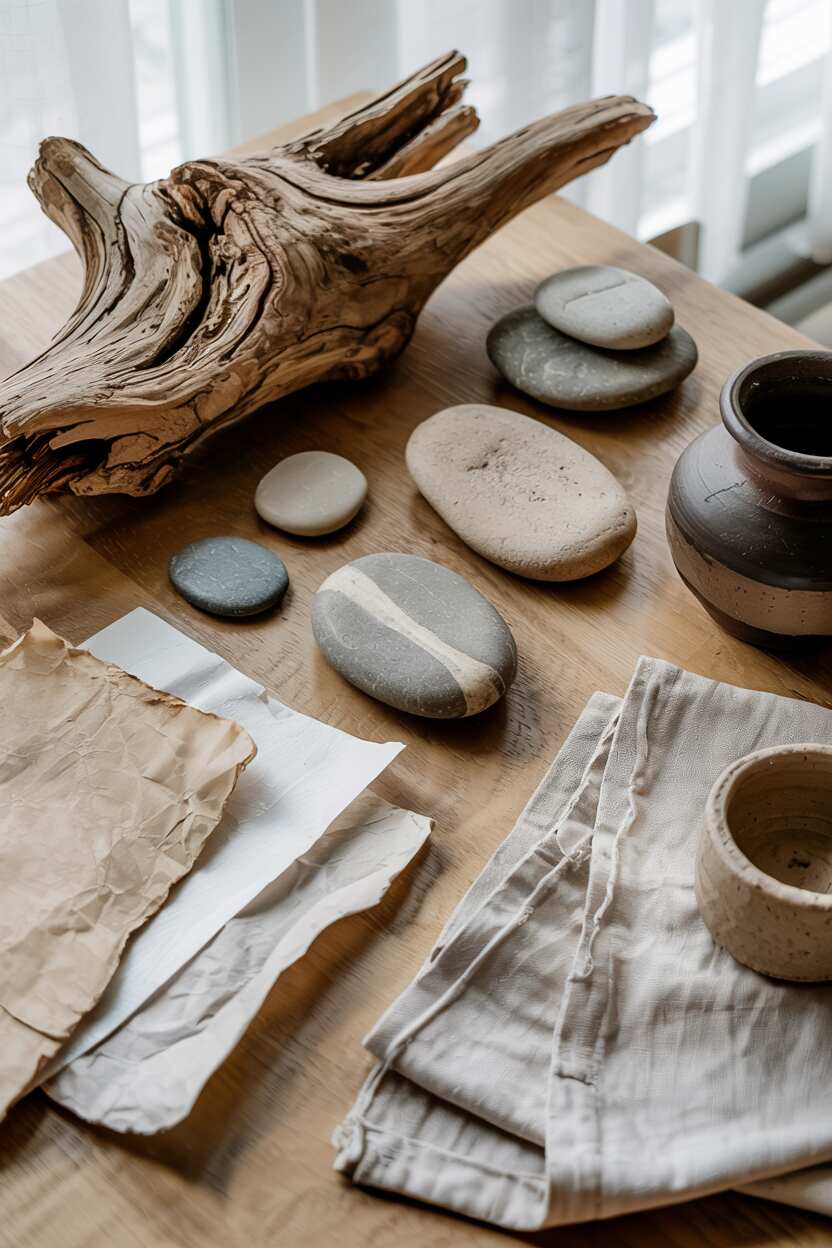
Woods that showcase knots, splits, and grain patterns are preferred over perfectly finished surfaces.
Stone with natural veining and irregularities brings an organic element to countertops and floors.
Clay, with its earthy character, appears in pottery and even walls through techniques like limewash or clay plaster.
Natural fibers like linen, cotton, hemp, and wool add textural richness through their inherent variations and how they wear over time.
These materials age gracefully, developing character rather than simply wearing out—linen that softens and wrinkles with use, wood that deepens in color and develops a patina, or leather that becomes more supple and distinctive with age.
Earthy and Muted Color Palette
The wabi-sabi color palette draws direct inspiration from nature, featuring subdued, earthy tones that create a sense of tranquility and groundedness.
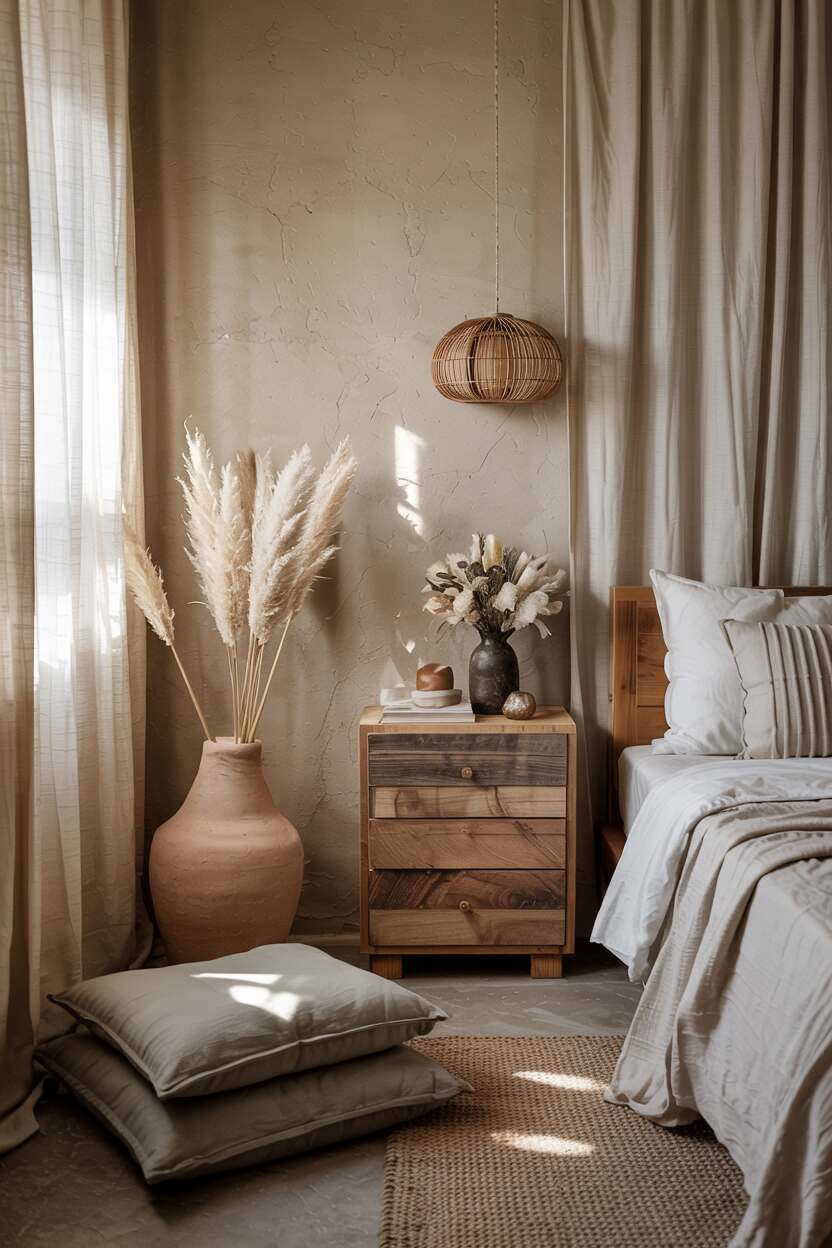
Neutrals form the foundation: warm whites, soft beiges, gentle taupes, and subtle grays create a calming backdrop that allows textures and subtle details to shine.
These are often complemented by muted nature-inspired hues—soft moss greens, faded indigos, subtle clay reds, and dusty blues—all appearing gently weathered by time.
This restrained color approach creates harmonious and serene spaces, allowing the eye to rest and the mind to quiet.
The colors in a wabi-sabi space never compete for attention but work together in an evolved, balanced composition.
Handcrafted and One-of-a-Kind Items
Wabi-sabi design celebrates the human touch evident in handcrafted items, valuing the slight irregularities that make each piece unique.
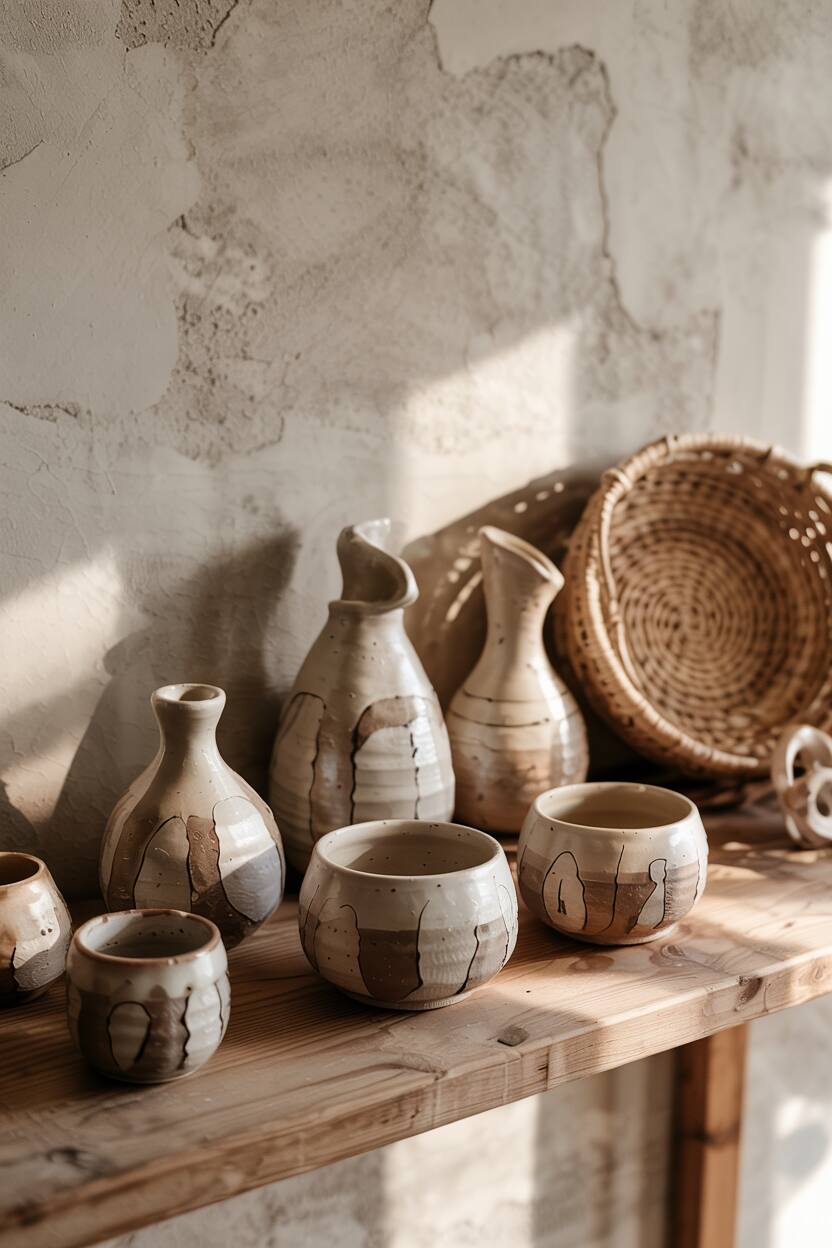
Artisanal ceramics with uneven glazes, hand-woven textiles with subtle variations, and furniture showcasing joinery and craftsmanship bring authenticity and soul to a space.
These objects carry the energy of their creators and develop their own stories as they age and adapt to use.
Vintage and antique pieces also embody wabi-sabi principles through their patina and signs of history.
A wooden table worn smooth by generations of use, brass hardware that has developed a natural patina, or stone steps gently concave from years of footsteps—these elements bring depth and character impossible to replicate in new, mass-produced items.
Minimalism with Character
Wabi-sabi embraces minimalism but differs significantly from stark, clinical minimalist approaches. It balances simplicity with warmth and character.

While unnecessary clutter is removed, each remaining element serves a functional purpose or provides meaningful beauty.
Spaces are allowed to breathe, with negative space being as important as the objects themselves.
This intentional spaciousness creates room for contemplation and appreciation of subtle details.
What distinguishes wabi-sabi minimalism is its warmth and soul. Rather than cold perfection, these spaces feel lived-in and personal.
Carefully curating fewer, better things with authentic character creates a profound sense of tranquility beyond mere visual simplicity.
Creating a Wabi-Sabi Home, Room by Room
Living Room
The living room offers abundant opportunities to incorporate wabi-sabi principles, creating a serene and deeply personal space.
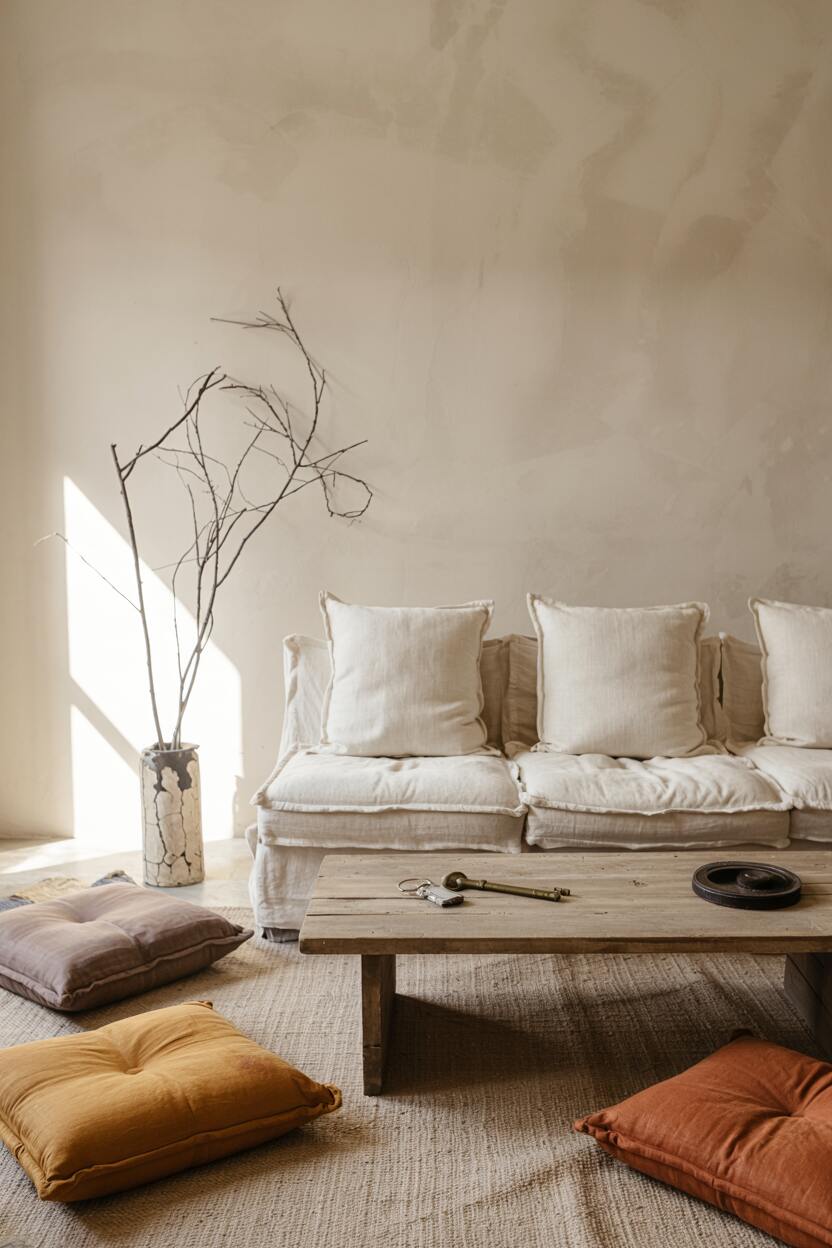
Start with natural textiles—linen or cotton slipcovers in earthy tones bring warmth while embracing their tendency to wrinkle naturally.
Choose furniture with visible craftsmanship and authentic materials, like a bench made from reclaimed wood or a chair with exposed joinery.
Create vignettes with meaningful objects rather than decorative fillers—perhaps a collection of smooth river stones, a handmade ceramic bowl, or a sculptural piece of driftwood.
Allow for negative space between elements, giving each piece room to be appreciated for its unique character.
Lighting should be warm and layered, with natural light prioritized during the day and soft, ambient lighting from paper lanterns or ceramic lamps in the evening.
The overall arrangement should feel balanced yet slightly asymmetrical, creating a natural flow that encourages relaxation and presence.
Kitchen
Often dominated by functionality and perfection, the kitchen can benefit tremendously from wabi-sabi’s authenticating touch.

Embrace the beauty of natural materials with wooden countertops that show grain patterns and develop character with use or stone surfaces with natural variations.
Open shelving displays beautifully imperfect handmade ceramics and wooden utensils with visible grain and craftsmanship.
Choose materials that age well and develop character—copper that develops a patina, wood that deepens in color, or clay tiles that show subtle variations.
Consider cabinetry that highlights rather than conceals the natural qualities of wood, perhaps with simple oil finishes that allow the grain to show through.
Functionality remains paramount, but tools and implements can be chosen for their authentic materials and craftsmanship—wooden spoons with beautiful grain, hand-forged knives that develop patina, or cutting boards that proudly display the marks of years of use.
Bedroom

Begin with the bed as the focal point, using natural fiber bedding like linen or cotton in soft, muted colors.
Embrace these materials’ natural tendency to wrinkle, seeing the texture as part of their authentic character rather than something to be perfected.
Keep furniture minimal but warm, with pieces that showcase craftsmanship and natural materials.
A wooden bedframe with visible joinery, a simple side table with beautiful grain patterns, or a bench made from reclaimed wood bring character without clutter.
Eliminate unnecessary items while keeping a few meaningful objects that bring joy—perhaps a ceramic vase with a single branch, a collection of smooth stones, or a handwoven basket.
The overall feeling should be spaciousness and tranquility, creating a genuinely restful environment.
Bathroom
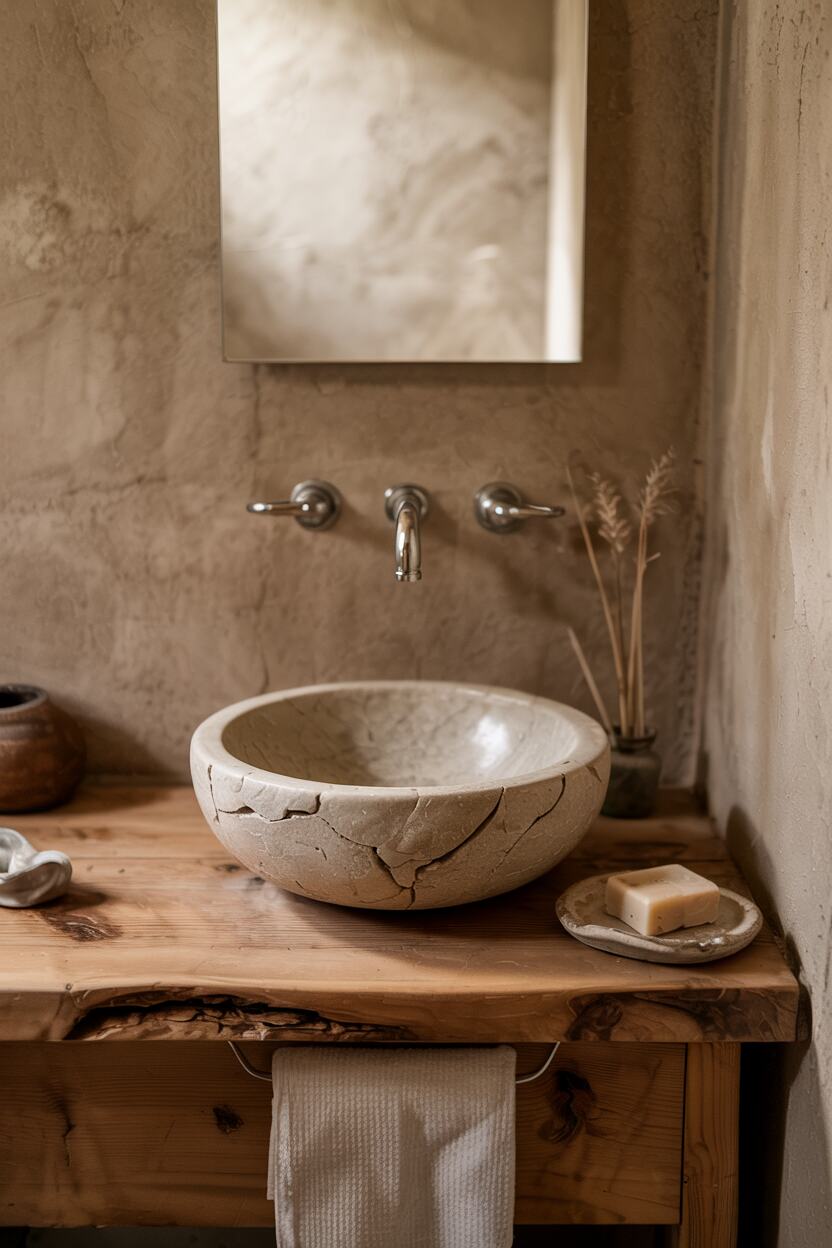
Focus on natural materials that feel grounding—stone basins with natural variations, wooden vanities that show grain patterns, or clay tiles with subtle color differences.
These elements create a connection to nature that feels both luxurious and authentic.
Incorporate bamboo, wood, and natural fibers through accessories like bath mats, towel ladders, or storage baskets.
These warm elements balance the typically hard surfaces of bathrooms, creating visual and tactile warmth.
Keep the space uncluttered, displaying only beautiful yet functional items, such as handmade soaps on a ceramic dish, essential oils in amber glass bottles, or a wooden stool with visible joinery.
The overall atmosphere should feel like a personal spa retreat—simple, natural, and deeply restorative.
How Wabi-Sabi Influences Mood and Atmosphere
The impact of wabi-sabi design extends beyond aesthetics—it fundamentally shapes how we feel in our spaces, promoting a sense of calm acceptance and mindful awareness.
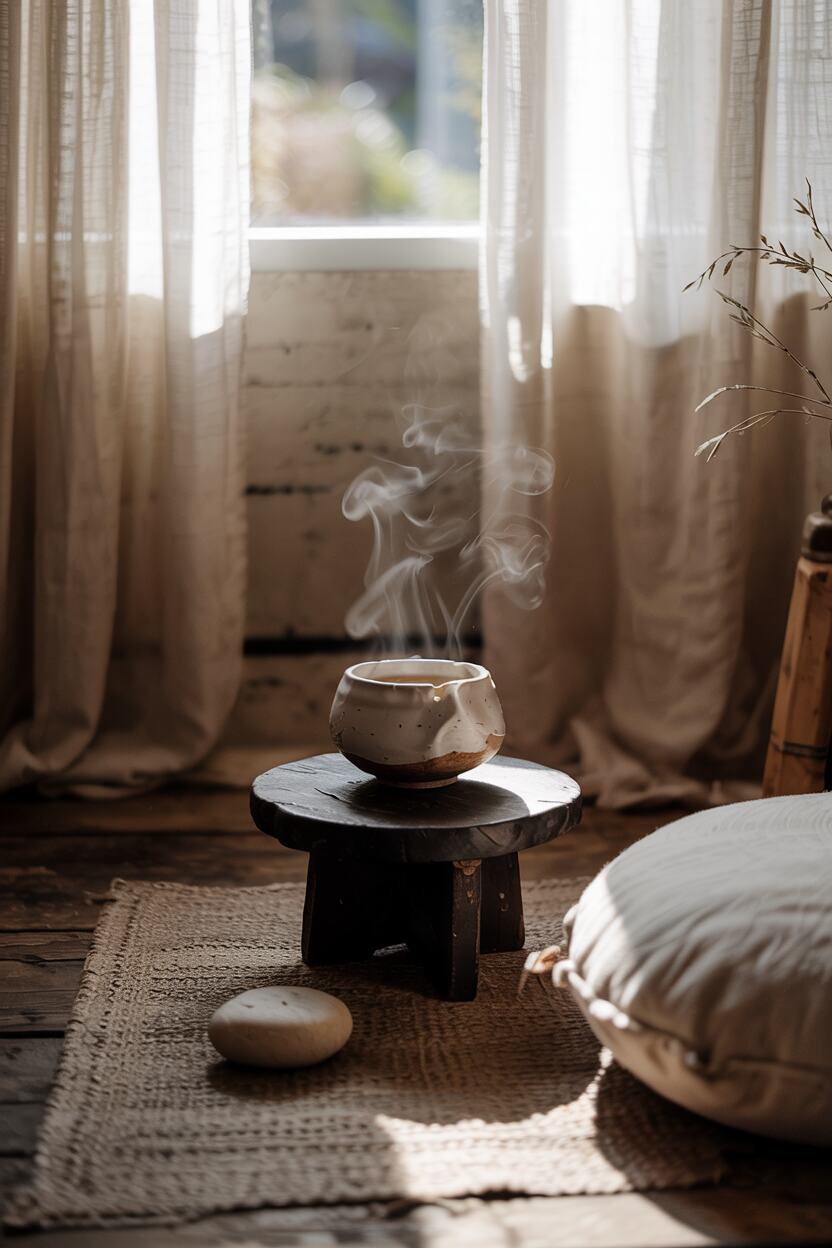
By embracing imperfection and transience, wabi-sabi interiors release us from the stress of maintaining flawlessness.
When cracks, wear, and aging are seen as adding character rather than diminishing value, our homes become places of acceptance rather than constant improvement projects.
The natural materials and muted colors create a sensory environment that calms the nervous system, while the minimalist approach reduces visual noise and mental clutter.
The overall effect is a space that feels like a sanctuary from the outside world’s perfectionism and pace.
Perhaps most significantly, wabi-sabi encourages a deeper connection with our surroundings.
When objects show their age and history, we value them more deeply, developing relationships with our spaces rather than simply consuming them.
This fosters a sense of groundedness and presence that is increasingly rare in our fast-paced world.
Combining Wabi-Sabi with Other Design Styles
Wabi-Sabi and Modern Design
While seemingly opposite in approach, wabi-sabi and modern design can create a compelling balance when thoughtfully combined.
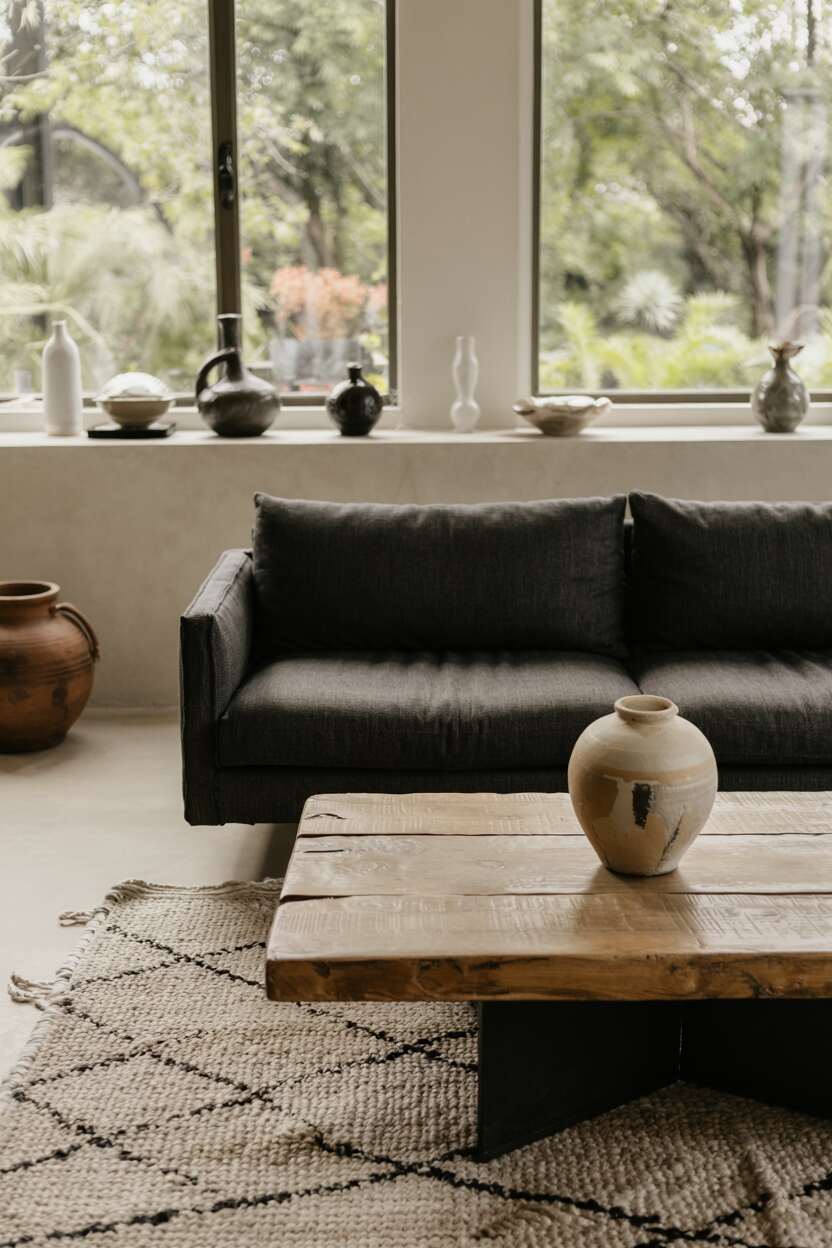
Modern design’s clean lines and architectural forms provide an excellent framework for highlighting wabi-sabi elements.
The simplicity of modern pieces allows the texture and character of natural materials to stand out dramatically.
To balance these styles, maintain the clean silhouettes of modern design while incorporating natural materials and handcrafted elements.
A sleek sofa might be paired with a naturally imperfect wood coffee table, or minimal architecture might showcase a wall with a natural clay finish or an imperfect handmade statement piece.
This combination works particularly well because each style emphasizes what the other lacks—modern design brings clarity and intentional structure.
At the same time, wabi-sabi adds soul, warmth, and a connection to nature and time.
Wabi-Sabi and Minimalism
Wabi-sabi and minimalism share a focus on simplicity but differ in their approach to perfection and texture.
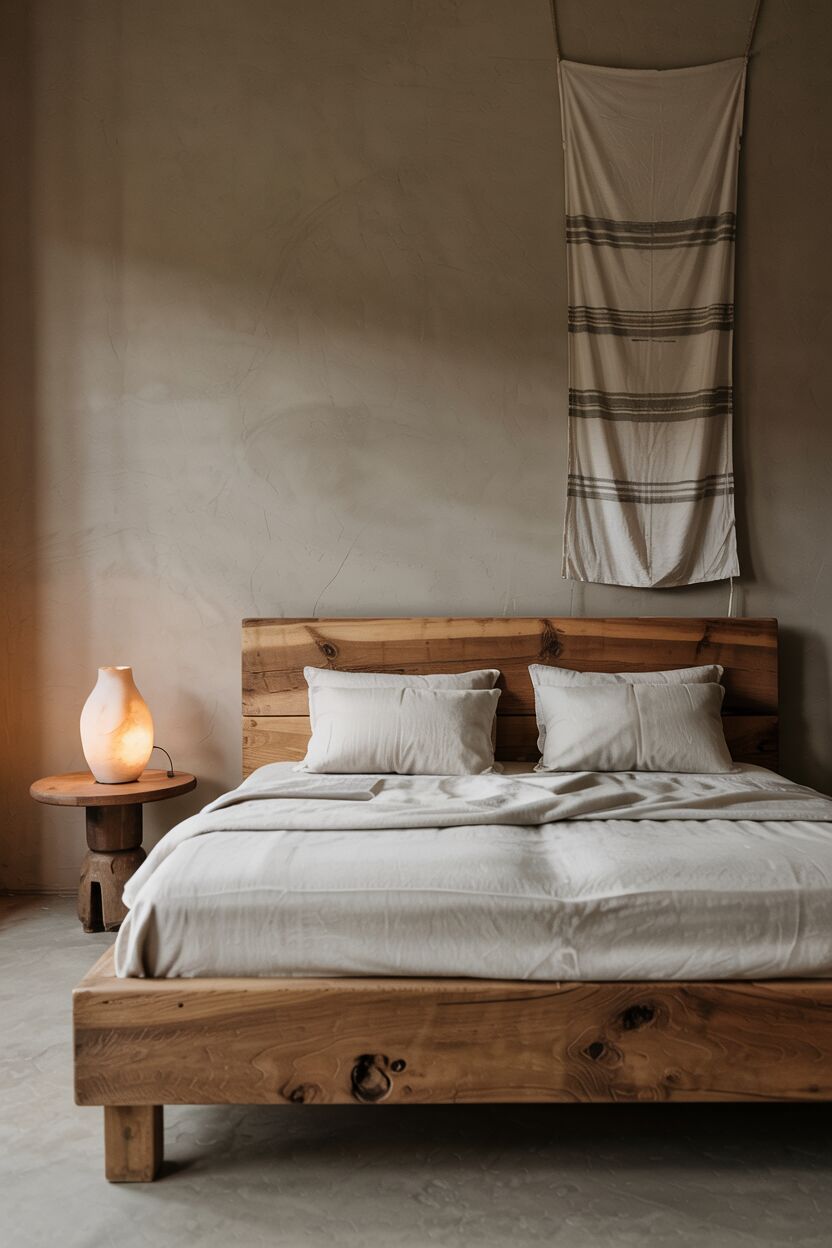
Traditional minimalism often emphasizes perfect surfaces, crisp edges, and clinical precision.
Wabi-sabi minimalism retains the “less is more” approach but adds warmth through natural materials, texture, and embracing imperfection.
To successfully combine these approaches, maintain minimalist principles of reduced clutter and thoughtful curation, but choose pieces with character, texture, and signs of craftsmanship.
A minimalist room layout might feature fewer pieces, each selected for its function, natural beauty, or interesting backstory.
This fusion creates spaces that feel intentionally designed yet profoundly personal—maintaining the mental clarity that minimalism offers while adding the soulful connection that wabi-sabi brings.
Wabi-Sabi and Japandi Style
Japandi—the fusion of Japanese and Scandinavian design—already incorporates many wabi-sabi principles, making this combination particularly harmonious.
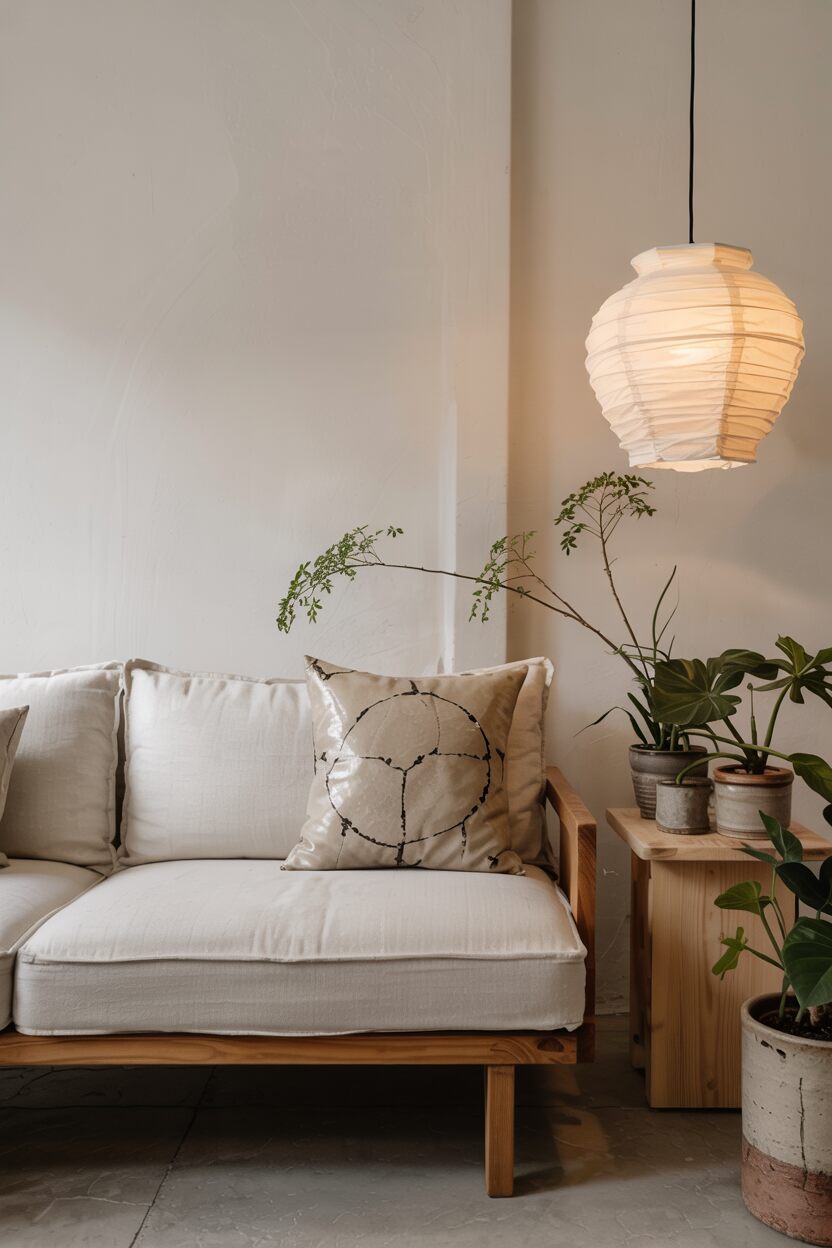
Japanese and Scandinavian design traditions value craftsmanship, natural materials, and functional simplicity.
Wabi-sabi adds a layer of acceptance for imperfection and the beauty of aging.
Combine the clean lines and light woods typical of Scandinavian design with the asymmetry and natural imperfection of wabi-sabi.
Warm the neutral Japandi palette with additional earthy tones and incorporate handcrafted elements with visible marks of their making.
This combination creates spaces that honor craftsmanship and natural materials while maintaining a clean, uncluttered aesthetic.
The result feels both contemporary and timeless, minimal yet warm.
Practical Steps to Incorporate Wabi-Sabi Principles
Starting Small
Embracing wabi-sabi doesn’t require a complete home renovation—it can begin with small, meaningful changes that shift one’s perspective on beauty and perfection.

Start by bringing in simple natural elements like branches, stones, or dried grasses arranged in vessels you already own.
Replace mass-produced accessories with one or two handcrafted pieces that show the marks of their making—perhaps a ceramic bowl, a wooden cutting board, or a handwoven textile.
Look for opportunities to embrace existing imperfections rather than hiding them.
That scratch on your wooden table or the crazing in an old ceramic piece becomes part of its unique story and character.
Even small textile additions, such as a linen tea towel, a raw-edged table runner, or a handwoven cushion cover, can begin to shift the feeling of your space toward the authentic warmth of wabi-sabi.
Curating with Intention
Wabi-sabi spaces are carefully curated, with each item chosen for its meaning, function, or beauty rather than as mere filler or decoration.
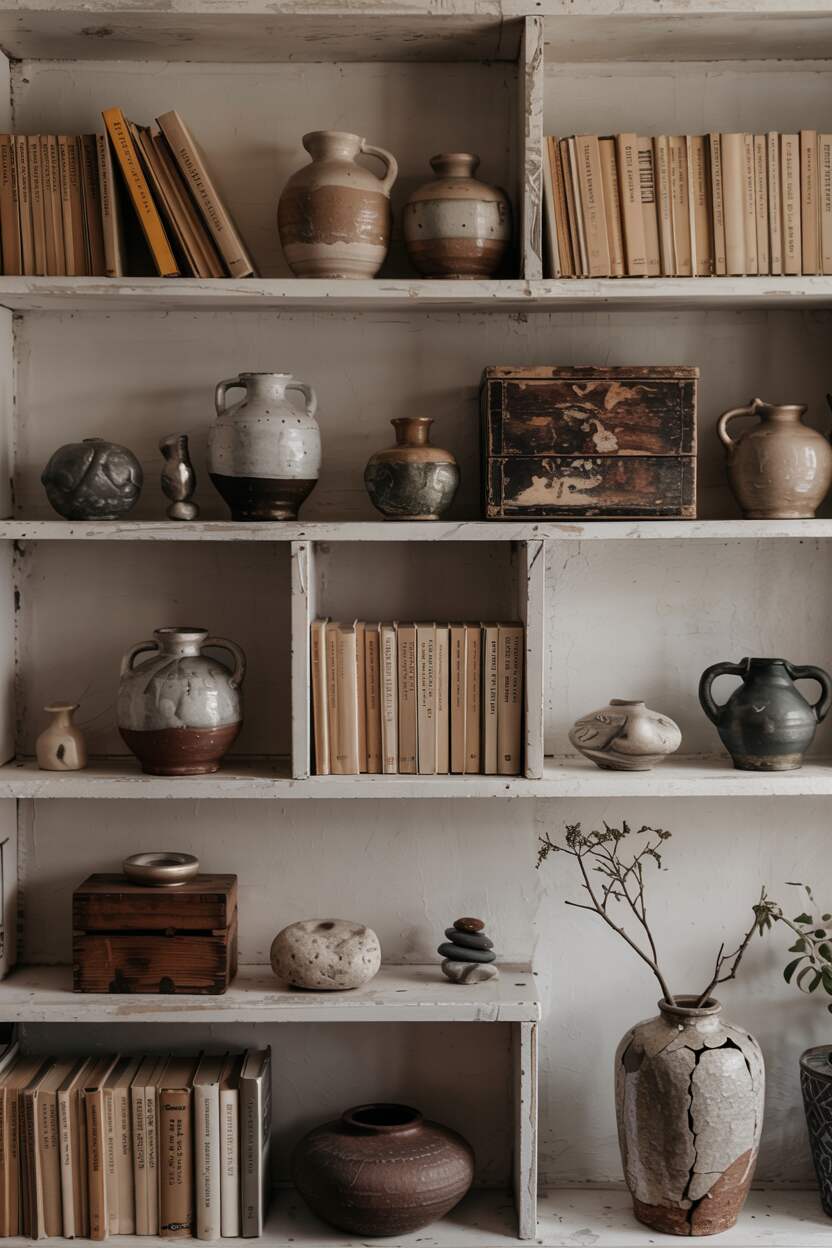
Begin by evaluating what you already own. Which pieces have developed character with age or tell a meaningful story? Which handmade or natural items bring you genuine joy? These become the foundation of your wabi-sabi collection.
When adding new items, consider their authenticity, craftsmanship, and potential to age beautifully.
Choose quality materials that develop character rather than deteriorate—solid wood rather than veneer, real leather instead of synthetic, natural fibers over polyester.
Create thoughtful arrangements with breathing space between objects, allowing each piece to be appreciated for its unique qualities.
A single branch in a ceramic vase might have more impact than an elaborate artificial arrangement; a stack of three beautiful stones more meaning than a mass-produced decoration.
Embracing Patina and Wear
Central to wabi-sabi is the appreciation for how materials change over time, developing character through use and exposure.
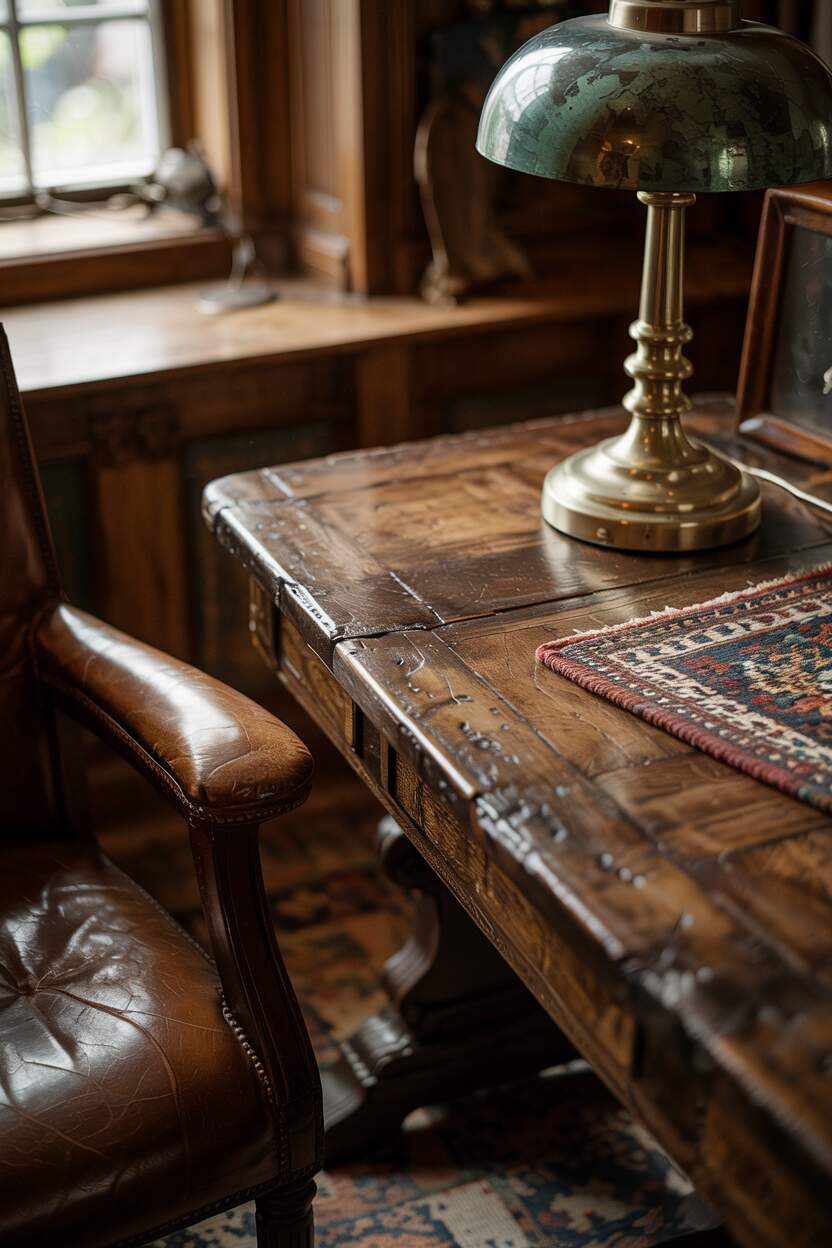
Rather than refinishing furniture at the first sign of wear, consider how the developing patina might enhance its character.
Wood that darkens with exposure to sunlight, leather that softens and develops a sheen where hands regularly touch it, and brass that darkens to showcase its use—these processes add depth and story to your surroundings.
Techniques like Kintsugi, the Japanese art of repairing broken pottery with gold, beautifully embody wabi-sabi principles by highlighting rather than hiding breaks.
Consider similar approaches when repairing beloved items—making the mending visible and beautiful rather than invisible.
Even regular maintenance can reflect wabi-sabi values.
Oiling wood rather than varnishing allows the material to breathe and change naturally.
Choosing natural cleaners and polishes that nourish materials rather than coating them supports their natural aging process.
Visual Inspiration Gallery
Serene Simplicity

The power of restraint creates a profound sense of peace in this space.
By limiting elements to only those with genuine meaning or function, the room breathes freely and allows each piece to be fully appreciated.
The natural materials and subtle textures provide visual interest without overwhelming the senses, creating an environment that calms the mind and encourages presence.
Natural Textures in Harmony
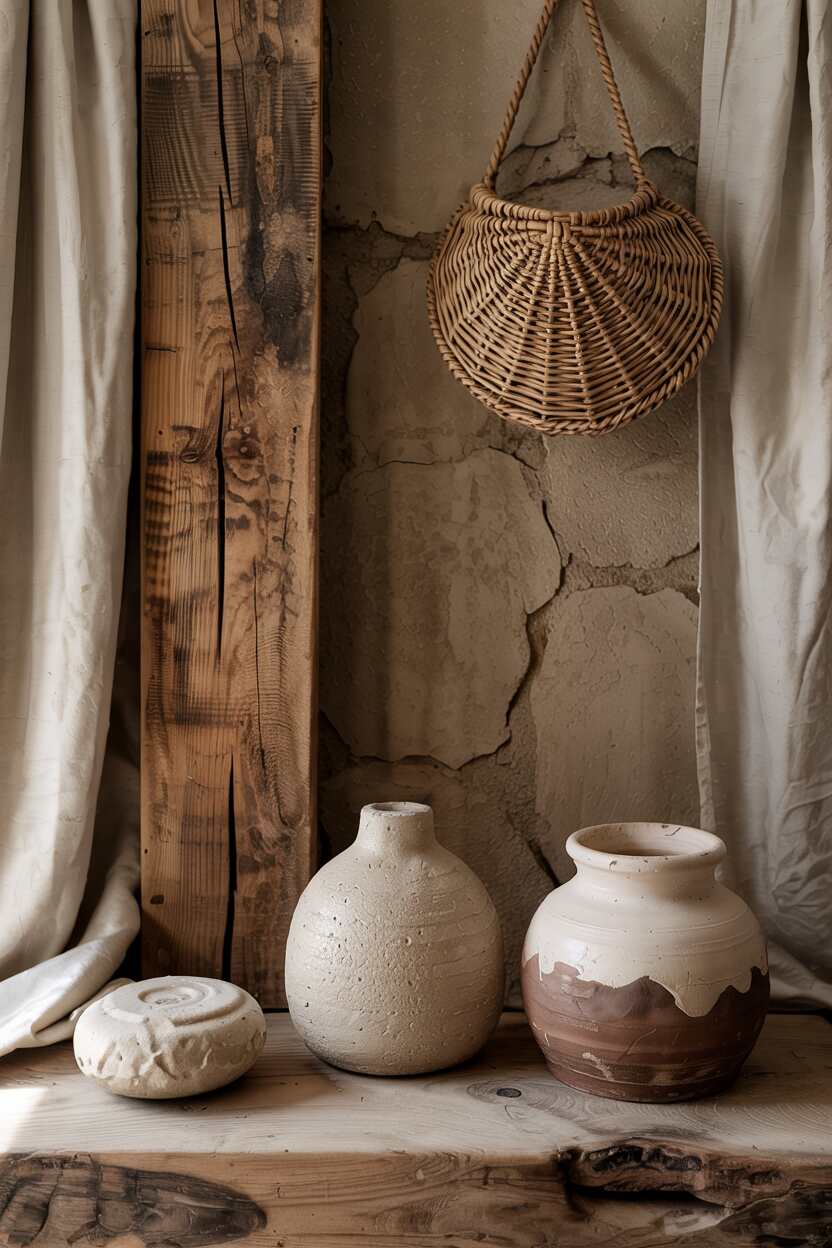
This textural arrangement demonstrates how diverse natural materials can create depth and interest while maintaining harmony.
Rather than competing, each texture complements the smoothness of stone against rough wood and the softness of soft textiles against hard surfaces.
This layering of tactile elements creates a space that invites touch and engages all the senses, making it feel deeply grounded and authentic.
The Beauty of Imperfection
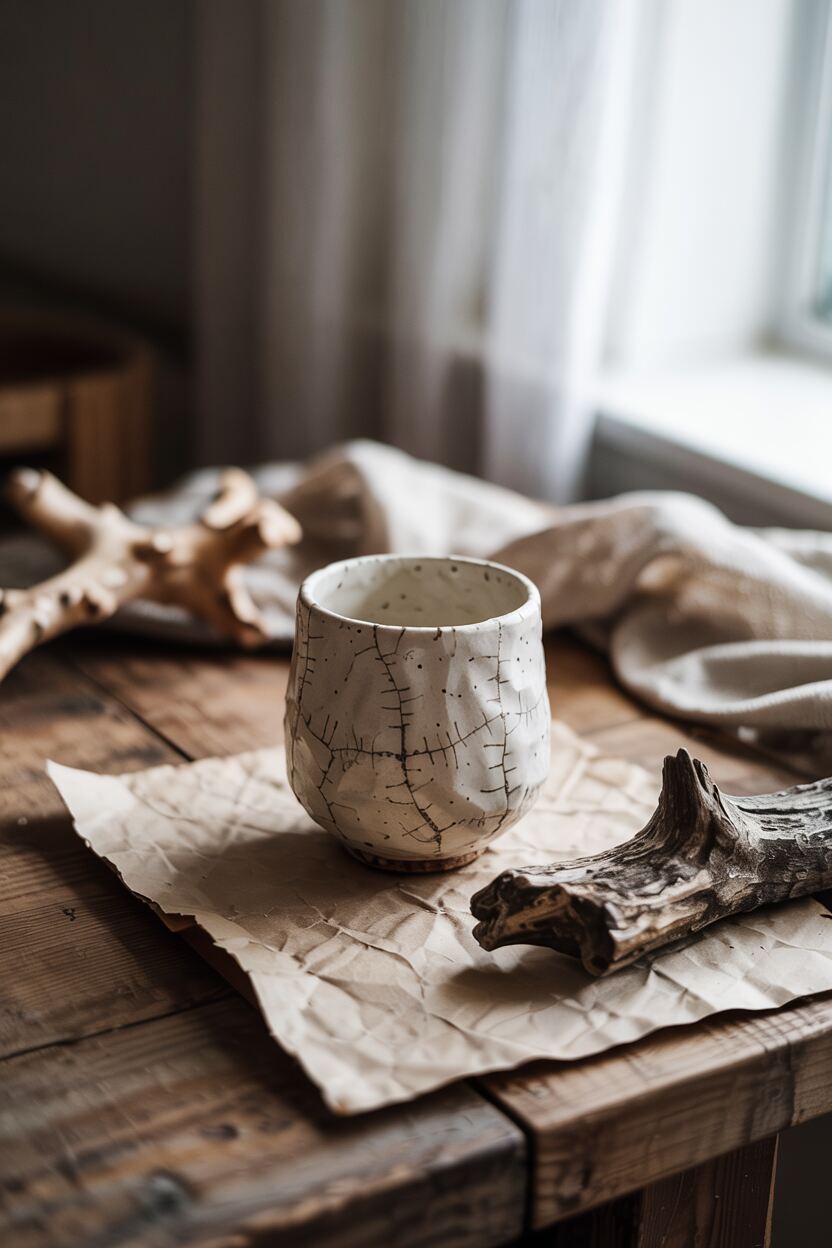
This detailed view reveals how what might conventionally be considered flaws become the most compelling aspects of these objects.
The irregular edge of a handmade ceramic piece shows the touch of its creator; the knot in wood tells the story of the tree’s growth; the uneven weave in a textile demonstrates the natural variations in the process.
These characteristics give each item uniqueness and soul that mass-produced alternatives could never possess.
Weathered Wood and Aged Metals

This arrangement celebrates the unique aging properties of different materials.
Wood deepens and smoothens with handling; copper develops blues and greens; iron gains a rusty warmth; bronze takes on complex tones through oxidation.
Rather than hiding these processes, wabi-sabi design highlights them as evidence of authenticity and the passage of time.
These materials tell stories that new, perfect items simply cannot—of use, care, and connection across time.
Handcrafted Ceramics

These ceramic pieces embody the wabi-sabi appreciation for the human touch in created objects.
Each piece bears witness to its making—finger marks preserved in clay, variations in glaze thickness creating unique patterns, and the slight asymmetry that comes from hand-forming.
No two pieces are identical, and precisely this uniqueness gives them value.
They connect us to ancient craft traditions while creating a counterpoint to mass production and perfect replication.
Mindful Minimalism
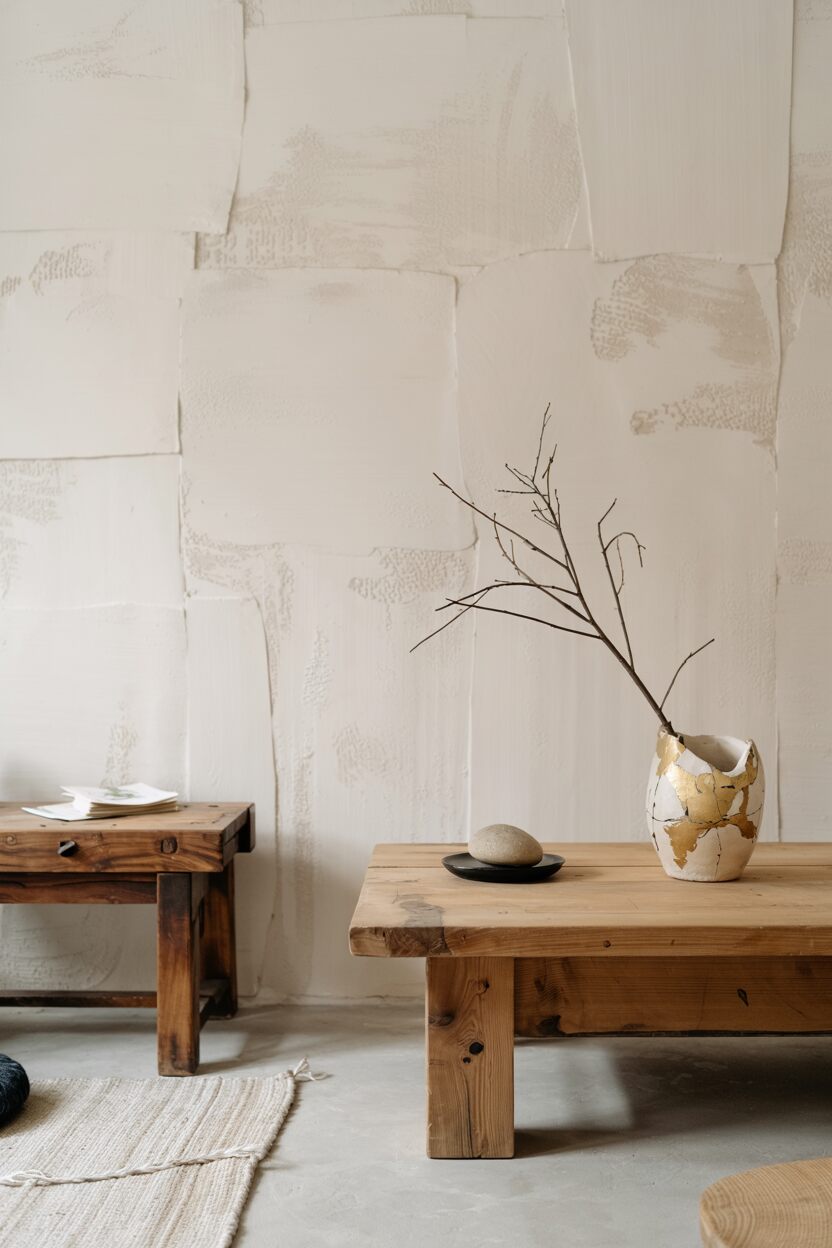
This carefully composed space demonstrates how wabi-sabi minimalism differs from more austere approaches.
While embracing simplicity and restraint, the space remains warm and soulful by emphasizing natural materials, visible craftsmanship, and objects with character.
The deliberate imperfection of each element creates interest without clutter, and the mindful arrangement provides ample negative space for contemplation and appreciation of subtle details.
Conclusion
Wabi-sabi interior design offers more than just an aesthetic approach—it presents a philosophy of living that embraces authenticity, imperfection, and the natural passage of time.
In our increasingly digital and perfect-seeking world, these principles provide a grounding counterbalance that reconnects us with nature, craftsmanship, and a more accepting way of inhabiting our spaces.
By embracing wabi-sabi principles in our homes, we create environments that celebrate rather than hide the marks of history and use.
We surround ourselves with materials that age gracefully and tell stories through their changing character.
Most importantly, we create spaces that feel deeply personal and alive, evolving alongside us rather than remaining in a state of sterile perfection.
Whether you incorporate wabi-sabi elements gradually or embrace the philosophy more fully, this approach to design encourages mindfulness, presence, and appreciation for the beauty found in imperfection.
Doing so transforms our homes from mere showcases into authentic sanctuaries that nourish our spirits and ground us in what truly matters.


